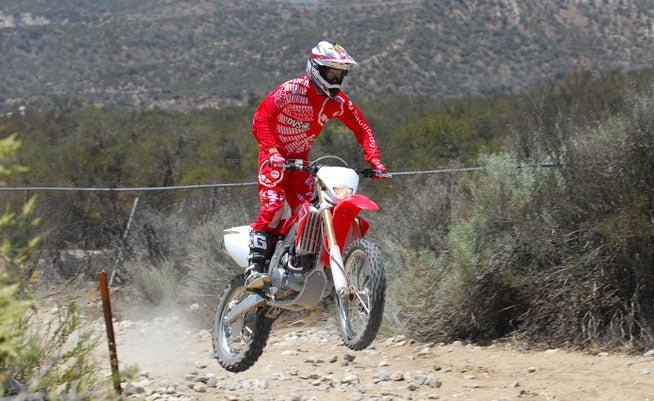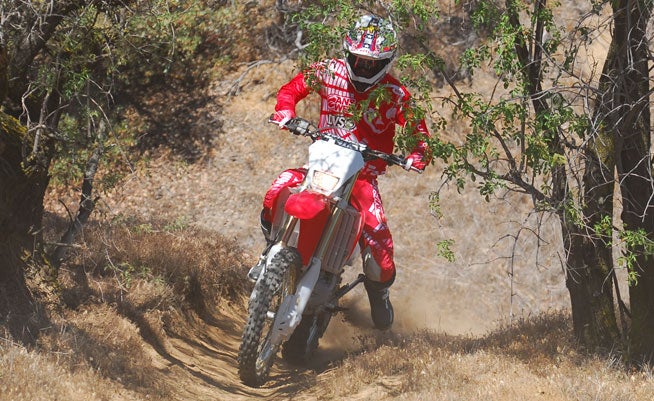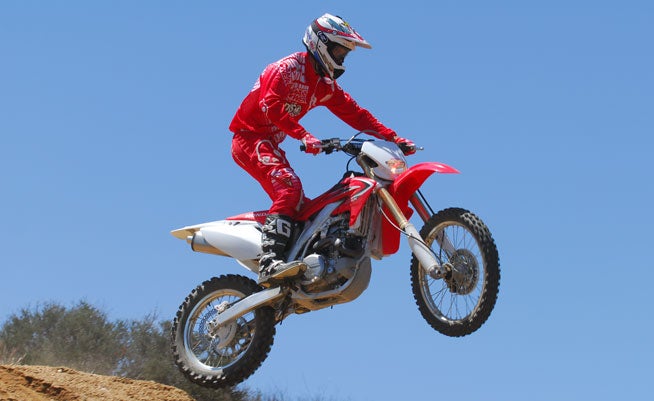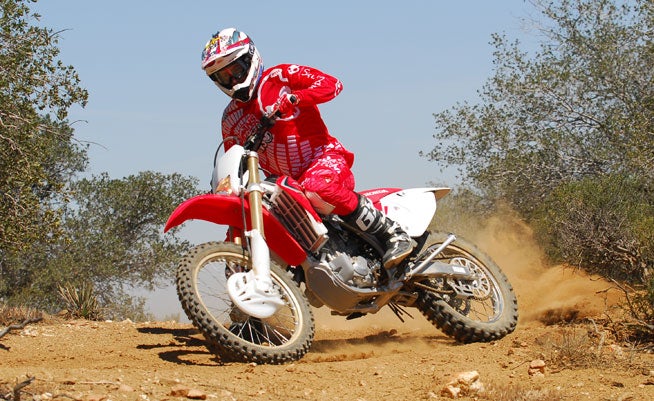Honda’s Open-class off-road flagship delivers predictable power and excellent stability for exploring the wilderness

Look up the word “dominance” in the dictionary, and it wouldn’t be unfathomable to see a photo of a red Honda off-road racer streaking across Mexico’s Baja California peninsula to illustrate the definition of the word.
Fact is, the Big Red brand enjoys an amazing 16-year unbeaten streak in the legendary Tecate SCORE Baja 1000, with most of those wins also including the outright fastest elapsed time in the race. And, despite seeing its 15-year unbeaten streak in the Tecate SCORE Baja 500 stopped by a Kawasaki team in 2012, Honda factory-backed Johnny Campbell Racing riders Tim Weigand, Colton Udall and David Kamo wasted no time in returning the brand to its winning ways at the 2013 Baja 500.
While many of Honda’s earlier Baja wins came aboard its XR-based off-road machines, the equally capable CRF450X has maintained a virtual stranglehold on Baja since it replaced the factory team’s XR650-based racer in 2006. Derived from the championship-winning CRF450R motocross bike, the X model has been the flagship in Honda’s off-road line since its introduction in 2005. Its strong points–a user-friendly Open-class engine, excellent suspension quality and ultra-stable handling at speed–make it a solid platform for everything from weekend play riding in stock form to Baja-winning performance, albeit with a few requisite modifications.
So when Honda offered DirtBikes.com the chance to try the 2013 CRF450X for ourselves (the X-model will be returning to Honda’s off-road lineup, unchanged, for 2014), we gladly accepted. It didn’t take but a few hours of riding to realize just how well the 450X maintains Honda’s legacy of producing great off-road machines.

The 450X’s single-cylinder four-stroke engine shares much of the technology found in the CRF450R. Rather than following the trend of larger, bulkier DOHC cylinder head designs, the CR450X uses a version of the compact Unicam four-valve cylinder head that was introduced on the CRF450R. Honda says that the Unicam configuration not only saves weight over a comparable dual-overhead-camshaft motor, but it also permits a narrow valve angle, effectively flattening the combustion chamber to facilitate ignition flame propagation and reduce the chance of detonation even with the X’s 12.0:1 compression ratio. Also, since less space is taken up in the cylinder head, the camshaft sits lower in the head for a lower center of gravity (cg).
But there are some marked differences in the X model’s fuel and ignition systems. For starters, the 450X uses a good old-fashioned Keihin 40mm flat-slide carburetor rather than the more high-tech fuel-injection system found on the 450R, but Honda engineers have narrowed the performance gap between the 450X’s carb and today’s state-of-the-art fuel injection systems by incorporating an EFI-style throttle position sensor to enhance the 450X’s throttle response. Another obvious change is that the 450X’s ignition system is designed with a coil to power its headlight and taillight.
Further separating itself from its motocross-bred sibling, the 450X uses a more off-road friendly, wide-ratio five-speed transmission to cover everything from tight, single-track trails to wide-open desert terrain. The 450X also adds the convenience of electric starting.

Bashing over some of our favorite wide-open stretches of Southern California desert or threading our way up and down single-track trails gave us a good understanding of the CRF450X’s engine performance, which we would rate as just shy of excellent. While the X motor’s design is a typical state-of-the-art four-stroke off-road engine, the racers amongst our test crew were left wishing for just a little more snap in the powerband. The 450X engine runs hard, and its TPS-controlled carburetion delivers smooth throttle response as the engine churns seamlessly from its low-end grunt into a top-end rush with no hitches along the way. Its clutch action is light and linear, and its five-speed transmission is buttery smooth, a quality for which Hondas is well renowned.
We would never accuse the big X motor of being slow, but we can say that it doesn’t feel as fast as other high-performance four-stroke off-roaders we’ve sampled. Possessing a character that’s easier to associate with the XR than the CRF motocrosser, it’s power delivery is smooth, but it isn’t snappy, and we wonder if raising the X’s compression another half a point to match the CRF450R’s 12.5:1 compression ratio would add a little more zip. As is, the CRF450X’s power output might best be characterized as a boil rather than a burn.
That isn’t a bad thing, however, as the user-friendly motor delivers a predictable chug, chug, chug down low that’s much more likely to endear itself to a wider range of customers, from weekend play riders to novice off-road racers, especially in rough or tight sections. It’s also noteworthy that the X motor also meets current California Air Resources Board (CARB) and EPA off-road emissions standards, so its performance potential is probably choked up a bit in stock form. The Baja success of Johnny Campbell Racing is proof positive that the CRF450X engine can be modified to win races.

The CRF450X’s aluminum perimeter chassis delivers freight train-style stability at the expense of slightly heavy steering response. That came as a bit of surprise, considering that its wheelbase checks in at 58.3”, almost half an inch shorter than the motocross-based CRF450R. And while the 450X’s rake is nearly identical at 27.1-degrees, its 4.3-inch trail is .27 of an inch shorter than the 450R’s. Those numbers suggest that the 450X should be able to carve turns as quickly if not quicker than the 450R, but the extra fuel carried in the X’s 1.9-gallon fuel tank (the R carries 1.6 gallons fully fueled) and additional off-road and emissions equipment add up to a significant 26.3-pound weight penalty over the motocrosser. Compounding the issue are the 450X’s 13.6-inch ground clearance and 27.9-inch seat height, .6 of an inch more and .5 of an inch taller than the 450R’s, which means that the 450X’s cg is also higher.
Some of the deliberate feeling may also stem (no pun intended) from Honda’s Progressive Steering Damper (HPSD), which is designed to act like a rising-rate suspension and increase damping force as the steering deflects further from its center line (straight ahead). It certainly helps keep the X stable at high speed, but the HPSD was noticeable when negotiating brushy single-track sections where quick turns are required to swing the handlebars back and forth between thick branches. While the 450X’s front end remains sure-footed, it lacks the light-steering feel of some of its competitors when the going gets really tight.
 Your Privacy Choices
Your Privacy Choices